In a world where the pace of business is accelerating and daily tasks are multiplying, managing meetings digitally has become a necessity, not an option. It is not just a means of exchanging opinions, but a strategic tool for ensuring implementation, achieving progress, and enhancing administrative discipline.
When meetings are managed digitally, professionally, through platforms such as:DocSuite Meeting transforms from a recurring burden into a real-world starting point for monitoring performance and improving team efficiency.
In this article, we will learn how managing digital meetings contributes to improving the efficiency of work teams.
What do organizations achieve from digital transformation in meeting management?
Institutional experiences have proven that relying on digital meeting management systems leads to tangible results on the ground. The most notable of these results are:
- Instant and professional documentation of meeting minutes
Instead of handwriting or taking scattered notes, digital meeting management systems allow for instant, organized, and easy-to-reference minutes. This ensures that no important point discussed is missed, preventing repetition and ensuring accurate follow-up.
withDocSuite Meeting: Minutes are automatically generated and can be categorized by meeting type (board, task forces, committees, etc.).
- Turning discussions into actual, measurable tasks
One of the most important benefits of modern meeting management is the direct connection between what is discussed and what actually needs to be accomplished.
But how? By generating specific tasks from the topics discussed, assigning them to responsible individuals with due dates, and the result is higher levels of achievement and less confusion between what is said and what is implemented.
- Automated follow-up of decisions and tasks
Thanks to the alerts and reminders feature, leaders don't need to manually monitor their teams. The system automatically monitors.
exampleIf a decision is made at a board meeting regarding a new project, the meeting management system will follow through with the required steps, without manual intervention.
Components of Successful Digital Meeting Management
For meeting management to be truly effective, it must include a number of essential components:
- Central meeting scheduling
It allows you to plan meetings in advance, easily invite stakeholders, ensures no scheduling conflicts, and achieves greater attendance.
- Managing the agenda and content before the meeting
It enables members to know the topics before the meeting, which increases the quality of discussion and reduces time wastage, and each agenda point links to evaluation topics and future reports.
- Voting and Decision-Making Tools
It enables participants to vote electronically within the meeting and document the results immediately. This method supports transparency and speeds up decision-making.
- Managing and institutionally preserving meeting minutes
Modern platforms not only store records, but also allow them to be categorized, archived, and shared within institutional frameworks.
How to enhanceDocSuite Meeting is an efficient way to manage meetings?
platformDocSuite Meeting isn't just for automating appointments, it's for managing correspondence, meeting minutes, follow-up tasks, and archiving in an integrated way. Here's what makes it stand out:
- Integration with administrative systems
Such as human resources or finance, allowing administrative outputs to be linked directly to plans and budgets.
- Smart Permissions
Each participant sees only what pertains to them, which maintains confidentiality and privacy.
- Meeting Performance Indicators
The system displays performance reports on meeting productivity, member commitment, and decision completion.
The impact of digital meeting management on corporate work culture
Digital transformation in meeting management is not just about tools; it creates a new culture within the organization:
- Culture of commitment and discipline
Where everyone knows what they are supposed to do, when they need to do it, and how they are held accountable.
- Raising the level of coordination between teams
Thanks to the central platform, the gaps between departments are reduced.
- Motivating teamwork
When follow-up is visible and shared, everyone is part of the achievement.
Traditional meetings or digital meetings
In many organizations, meeting management is still practiced in the same traditional way: scattered papers, forgotten minutes, unfollowed tasks, and decisions that don't find their way to implementation. However, with digital development, integrated systems for meeting management have emerged, such asDocSuite Meeting has revolutionized the way we work. Let's compare the two models:
First: Before the meeting
Traditional meetings:
Agenda preparation is often done manually or via email.
There is no clear way to share attachments or preparatory materials.
Overlapping schedules and poor coordination between teams are common.
Digital meetings:
The agenda is set up through the system, with smart notifications for all members.
Documents, presentations, and reference materials may be attached to the meeting.
The scheduling system prevents conflicts and suggests the best times based on team availability.
Second: During the meeting
Traditional meetings:
Discussions extend without a time frame.
There is no accurate record of what was said or decided.
It is difficult to ensure that everyone is committed to the agenda.
Digital meetings:
The agenda is managed by the system, and attendance and voting are recorded automatically.
Important points can be documented in the minutes directly during the meeting.
Controlling time and topics prevents going off-topic.
Third: After the meeting
Traditional meetings:
Delay in issuing the report, or not documenting it at all.
Task tracking is done manually or via separate messages.
There is no way to evaluate the effectiveness of the meeting.
Digital meetings:
The minutes are generated automatically and sent to all parties immediately.
Tasks are created from within the minutes, with due dates and reminders.
Meeting performance, completion rate, and shortcomings can be measured.
Why is digital transformation necessary in meeting management?
Digital transformation is essential in meeting management because:
- Because time is the most important resource in organizations
Every minute in a meeting costs the organization human and material resources, so using effective tools such as:DocSuite Meeting ensures that this time is used most efficiently.
- Because corporate documents must be managed professionally.
Through digital management of minutes, votes, and accompanying correspondence, documents become part of a smart system that is easy to retrieve and link to decisions.
- Because manual follow-up is no longer effective.
Digital meetings give management the ability to track the implementation of tasks and decisions through real-time reports without the need for constant communication or spam.
The strategic return from improving meeting management
When an organization adopts an integrated system for managing meetings such as:DocSuite Meeting not only improves the performance of the meetings themselves, but also achieves strategic gains across the entire organizational performance. Here are the most important benefits for the organization:
- Speed up decision making
When meetings are managed digitally, decisions become documented, clear, and easy to track. This reduces the time lost between "proposing a decision" and "implementing it," increasing the organization's response speed to changes and opportunities.
- Promoting accountability and transparency
Every decision is recorded, and every task is associated with its owner's name and due date. This means that every individual in the organization knows their role and senses their responsibilities, creating a work environment based on clarity and accountability.
- Improving corporate communication
By linking meetings to agendas, reports, and correspondence, meeting management becomes a focal point for coordination between different departments, eliminating the need for unnecessary repetitive meetings or exchanging hundreds of messages to find out what has been decided.
- Corporate Compliance Support
Documenting meeting minutes and decisions in a digital system makes it easier for audit and quality departments to access them when needed. This supports compliance with governance policies and enhances the organization's readiness in the event of internal or external reviews.
- Improving the effectiveness of boards of directors
With platforms likeWith DocSuite Meeting, board meetings become more organized, with reports, supporting materials, and pre-listed bullet points available. Electronic voting is also possible, and minutes are distributed immediately after the meeting, saving significant time and effort.
- Saving operational costs
By eliminating printing, internal mail, manual reminders, and ineffective recurring meetings, the organization achieves significant financial savings in resources wasted on traditional processes.
Moving from scattered manual management to managing meetings digitally through tools such asDocSuite Meeting isn't a technical luxury, but a strategic step that increases an organization's efficiency and ensures the sustainability of its decisions. Every minute managed professionally is an investment in time, every documented report ensures the integrity of procedures, and every meticulous follow-up of tasks is a step toward achieving goals with clarity and discipline.
 تعرف معنا كيف تسهم إدارة الاجتماعات الرقمية في رفع كفاءة فرق العمل؟
تعرف معنا كيف تسهم إدارة الاجتماعات الرقمية في رفع كفاءة فرق العمل؟








Comments
Add New Comment